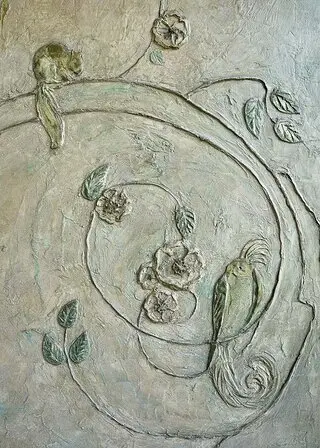
Get Up Close to Artist Grant Wood's Charming Mural at Brucemore
At Brucemore, a National Trust Historic Site in Cedar Rapids, Iowa, visitors are able to glimpse early artwork from an American master. In 1925, Brucemore owner Irene Douglas commissioned the up-and-coming Cedar Rapids artist Grant Wood—who would go on to paint the iconic American Gothic in 1930—to design the walls of an open-air, second-story sleeping porch off her daughter’s bedroom.
He painted a low-relief mural depicting local woodland creatures such as rabbits, squirrels, and birds hidden among vines and flowers, all in soft blue and green hues. “It’s meant to be very naturalistic,” says Jessica Peel-Austin, Brucemore’s curator of museum collections. “It does a really nice job of blending the fact that the sleeping porch is both an exterior and interior space, and I think evokes a lot of the landscape around the estate, as well.”
When the National Trust acquired Brucemore in 1981, Wood’s mural wasn’t in great shape; he painted over basic household plaster, and there’s no evidence he used any special techniques to ensure longevity in a battle against the elements. But enough of it remained intact for the site, backed in part by National Trust grants, to hire Michigan-based conservators Anthony and Mata Kartsonas in 2013. They spent the entire summer in Cedar Rapids injecting a chemical mixture behind the plaster, which had been pulling away from the brick surface, to let it re-adhere. They also removed shellac, likely applied by either the Douglas family or subsequent owners, to bring out the original colors.

photo by: Matthew Gilson
The low-relief mural turned 100 in the summer of 2025.
Since then, Brucemore has kept a close eye on the sleeping porch, which, while still fragile, now benefits from a climate-stabilizing geothermal HVAC system and UV-filtering, double-pane glass windows. The site celebrated the mural’s 100th anniversary this summer with tours, presentations, painting classes, and birthday cake. “For the porch to still be here,” says Peel-Austin, “is pretty remarkable.”



